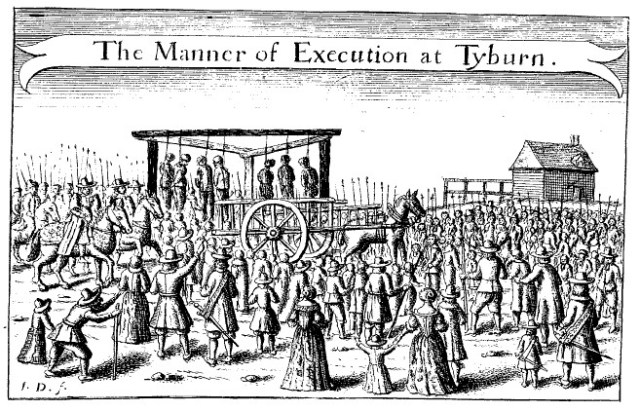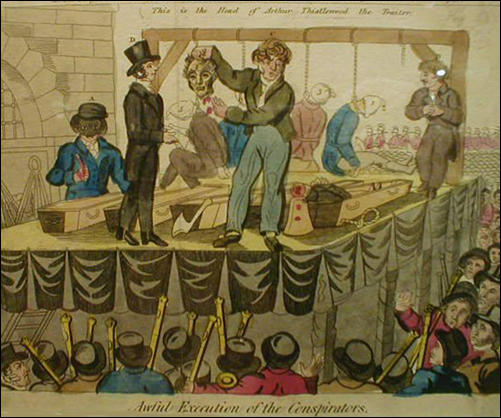The King’s head was held up to the crowd. The spectators, some who had watched in approval and some in dismay, were quickly dispersed by officials, but a few sought grisly souvenirs of the event rushing forward to dip their handkerchiefs into the royal blood, ‘by some as trophies of their villainy; by others as relics of a martyr. The execution of Charles the First 1649.
Tens of thousands of spectators saw the King’s head in the executioner’s hands and in the early 1660s they saw Regicides ‘hung, drawn and quartered’. This was very important in a revolutionary period as there had to be no ambiguity about the power of the state. Public execution served a legitimate purpose. Public executions over the next 200 hundred years lost legitimacy. Capital punishment was extended to 220 offences and executions acquired a circus like atmosphere. A depraved atmosphere. Public executions were frequent and well attended. They fell into disrepute in the Victorian era. Gory spectacles ceased to be entertaining. In 1868 they stopped altogether. Executions were held inside prisons until abolition in 1965.
Samuel Pepys attended both Charles’s execution and that of the Regicide Major-general Harrison. On both occasions he supported the execution. Pepys proved Cromwell’s aphorism true: “Do not trust to the cheering, for those persons would shout as much if you and I were going to be hanged.*” His description of the execution of Harrison is famous:
“I went out to Charing Cross [London] to see Major-general Harrison hanged, drawn, and quartered; which was done there, he looking as cheerful as any man could do in that condition. He was presently cut down, and his head and heart shown to the people, at which there was great shouts of joy.*”
Pepys’s career depended on applauding the brutal execution of Regicides.
James Boswell attended his first execution in 1763. He declared that he was, “… most terribly shocked, and thrown into a very deep melancholy.***” Those feelings didn’t last very long. In 1768 he said, “Of all publick spectacles, that of a capital execution draws the greatest number of spectators. And I must confess that I myself am never absent from any of them.****” Boswell, a highly educated, sensitive man enjoyed executions, which reflected common attitudes. London’s Tyburn ‘Tree’ could hang 24 prisoners simultaneously adding to the excitement. Boswell attended all eight annual ‘hanging’ days, fuelling his gruesome entertainment*****.
It should be remembered that the entertainment executions provided began well before the ‘drop’ and extended afterwards. In York for example: “Execution day was a big, rowdy event – criminals were a spectacle as they were driven from the prison to their deaths, sitting with their coffins. Until 1745 their bodies were quartered after hanging.******” In Lancaster there was an attempt to have some sort of solemnity by partially separating the main body of the crowd away from the gallows. “High railings surrounded the drop area and the spectators were allowed up to these, within a few feet of the gallows. Many more crowded onto the opposite bank to get a good view of the proceedings.*******” Needless to relate the crowds were rowdy, drunk and turned executions into a sport.
The execution of the Cato Street Conspirators in 1820, demonstrated a lessened appetite for gory spectacular punishments. The five principal defendants were sentenced to be hanged followed by decapitation. A special commemorative axe was made for the executioner but wasn’t used. Presumably the authorities were concerned that a botched decapitation might trigger a riot. The execution attracted 100,000 spectators********. Fourteen years later the pace of change was increasing. In 1834 523 criminals were sentenced to death but only 34 were executed- presumably the remainder were transported to Australia. The brutal 18th century was being replaced by a kinder, gentler era.
Parliament established a Royal Commission on Capital Punishment in 1864. The Commissioners’ report was unequivocal in declaring that executions should take place within prisons. About a third of the Commissioners went further and argued for abolition. Parliament enacted the findings of the Royal Commission and so ended the depraved spectacles associated with public execution. A brutal part of British life ceased, without protest, in 1868.
*http://www.preachingtoday.com/illustrations/1997/august/2575.html
**https://www.pepysdiary.com/diary/1660/10/13/
***https://teainateacup.wordpress.com/2012/10/26/james-boswells-trip-to-tyburn/
****http://www.executedtoday.com/tag/james-boswell/
***** For a long and very vivid description go to http://www.capitalpunishmentuk.org/hangedt.html
******http://www.historyofyork.org.uk/themes/executions-in-york The magistrates in York were so disturbed by the mob that they abandoned public executions in 1801, 67 years before the national ban.
*******http://www.capitalpunishmentuk.org/lancast.html
********https://www.bl.uk/collection-items/axe-created-for-the-execution-of-the-cato-street-conspiracy-ringleaders The heads were surgically removed before being displayed to the crowd. Soldiers were present to quell rioting. Its certain that a 17th century mob wouldn’t have flinched at heads being hacked off.


